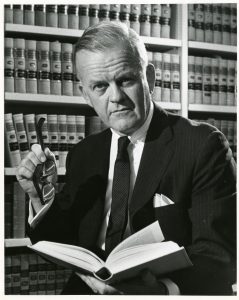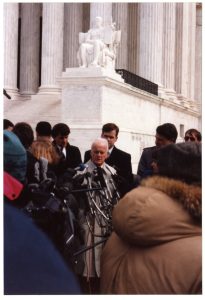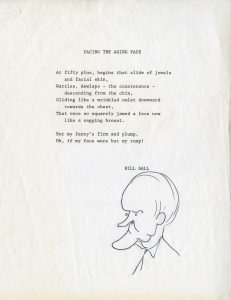
This week’s post is guest-authored by Austin Arminio, a graduate student in the field of Library and Information Science.
Currently, about ten percent of students in the United States attend private schools, the majority of which are run by religious institutions. While they likely don’t know his name, many of these students owe their ability to go to these schools to William Bentley Ball. This October 6th is the 101st anniversary of the birth of William Bentley Ball, whose devout Catholicism and passion for constitutional law led to him defending student’s rights to religious education.

Growing up in Cleveland, Ohio, Ball was a patriot and devout Catholic from an early age. When the United States entered World War II, Ball joined the Navy, obtaining the rank of Lieutenant Commander, after which he studied law at Notre Dame. Following college, Ball begin teaching constitutional law at Villanova University, as well as serving as a general counsel for the Pennsylvania Catholic Conference, the public policy wing of the Roman Catholic Church in Pennsylvania. In 1967, Ball worked on his first case before the United State Supreme Court: Loving v. Virginia. On the case that would overturn laws prohibiting interracial marriage, Ball entered a brief on behalf of 25 Catholic Bishops in support of the Loving’s position. This would be the first of many Supreme Court cases Ball would be involved in.
The case the propelled Ball into the national spotlight was 1972 case of Wisconsin v. Yoder. Jonas Yoder was the member of an Amish community in Green County, Wisconsin and following his children’s completion of the 8th grade, Yoder attempted to pull his children out of school, as the Amish believe that high school education unneeded for their way of life. This view led to conflict with state and national compulsory education laws, leading to Yoder being fined by the county. As the case reached the Supreme Court, William B. Ball agreed to represent the Yoders free of charge. Before the Supreme Court Ball argued that forcing Amish children to attend high school was forcing them to violate their religious beliefs. “Whether the Amish religion itself is unreasonable is not relevant, the plain facts are that the state (whether acting reasonably or otherwise) is preventing the defendants from performing their religious obligation.” The Supreme Court agreed with Ball and in a 7/2 decision ruled in favor of the Yoders.

Besides Wisconsin v. Yoder, Ball’s most famous Supreme Court case was the 1993 case of Zobrest v. Catalina Foothills School District. James Zobrest was born deaf, and as a result was provided a sign-language interpreter while he attended public school. However, when he began to attend a Catholic high school, the school district refused to continue providing Zobrest with an interpreter, saying they could not provide public education funds to a religious school. The Zobrest family argued that this was religious discrimination, and took the case to court. Ball argued before the Supreme Court that the school district’s refusal was a violation of the Individuals with Disabilities Education Act, as well as the Free Exercise Clause of the 1st Amendment. In a 5-4 opinion, the Supreme Court sided with Zobrest.
William Bentley Ball died January 10th, 1999 following a short illness. Over the course of his luminous carrier, Ball argued 9 cases before the US Supreme Court, having a win/loss margin of 5/3. Ball additionally served as an advisor on 25 other Supreme Court cases, as well as giving his testimony on numerous state and federal laws concerning the 1st Amendment. When not practicing law, Ball was an artist and poet, loved for his cheeky caricatures and limericks, some of which can be viewed here, here, and here. To find out more information about William Bentley Ball, you can view the finding aid to Ball’s collection here.
